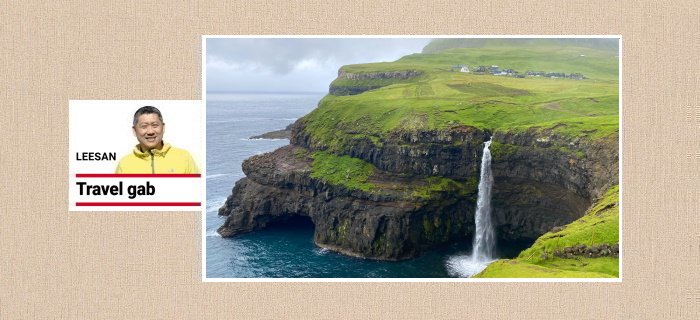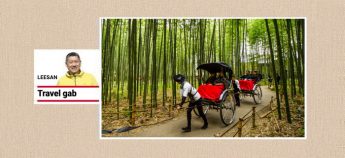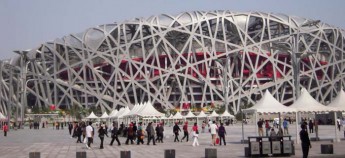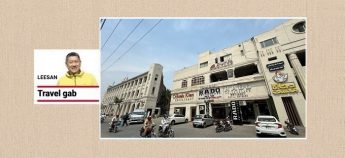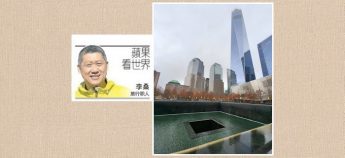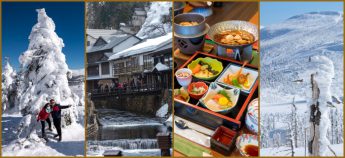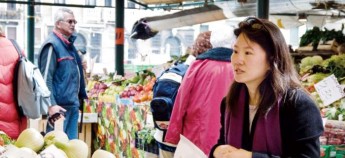A country of islands – by leesan
Faroe Islands not only has an interesting history, but it is also a very beautiful place with more sheep than humans.
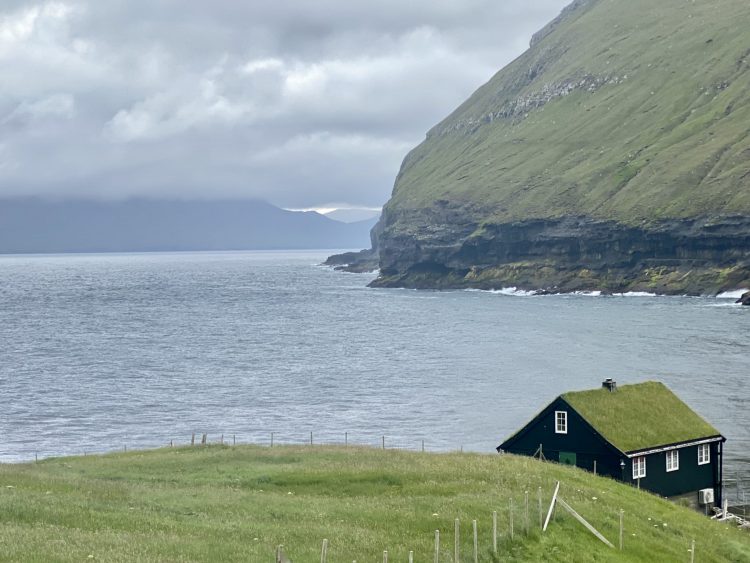
The total population of the picturesque Gjogv village is just 49. Living in such a breathtaking and magnificent scenery, the citizens seems are on vacation every day.
WHEN I was a young boy, I collected stamps as a hobby and there were these stamps from two “countries” that I thought were pretty common back then – Yugoslavia and Faroe Islands.
Today, Yugoslavia is just a name you’ll find in history books since it split into five successor states between 1991 and 1992.
Meanwhile, Faroe Islands looks like it has remained the same peaceful and rustic place it has been since the 8th century … The Faroese like to joke that they are “working very hard to reproduce, but can’t even catch up with the sheep on the island!”
Made up of 18 volcanic islands, Faroe Islands is located within the Atlantic Current Zone. It is an offshore special autonomous region of both Denmark and Greenland. The Faroese have been living in the middle of the ocean since time immemorial, and this somewhat has shaped them into becoming a bunch of happy-go-lucky folks.
The islands have over 75,000 sheep, 12,000 cows, countless birds and some free-range chickens. Meanwhile, the human population here is 54,000.
You can probably guess that meat, especially lamb and beef, are the staple food here. (The braised lamb shank at a restaurant called Aarstova in the capital Torshavn is to die for.)
Some folks also eat a local seabird called the rhinoceros auklet.
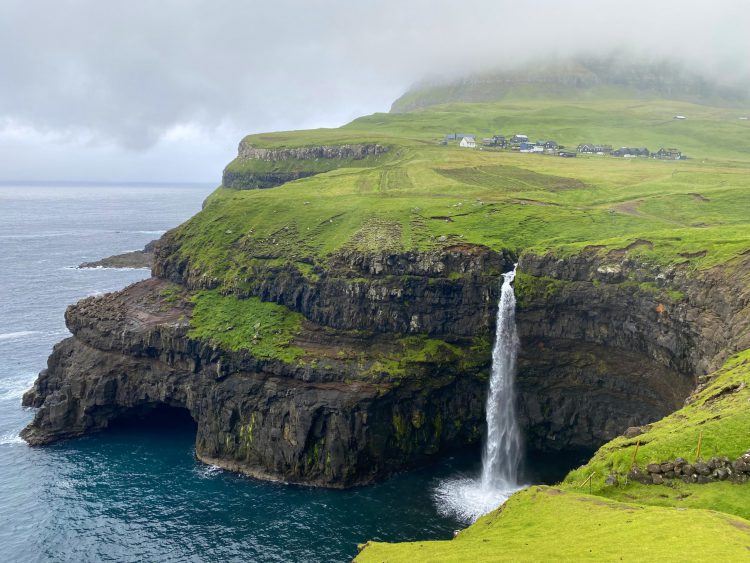
The Mulafossur waterfall in Gasadalur, one of the many islands Faroe. The Gasadalur is near a mountain, upon whch you can find a small village with 24 inhabitants. – Photos:Apple Vacations
The land on these sparsely populated islands is hardly arable, forcing the islanders to turn to the sea for livelihood. But the Faroese are born seaman and fishermen anyway so this makes sense. Fishing makes up a whopping 90% of the local economy; deep sea cod is their biggest catch and commodity.
Faroe Islands measures about 1,400sq km in area. Along the coastal road you can see plenty of salmon breeding farms, a burgeoning industry here. Each fish farm circle has 75,000 salmon fry, which carry a value of many millions in euro dollars.
The Faroese also engage in whale fishing, which is a non-commercial, traditional practice that has been passed down for over four centuries. The fishing folk only catch long-finned pilot whales as well as limited numbers of white-sided dolphins, as these are considered “non-endangered” species.
This year, the Danish government is only allowing the capture of not more than 500 white-sided dolphins.
The fact is, if the Faroese are not allowed to eat food from the sea or sky, they may probably starve to death as agriculture here is almost non-existent; the islands are covered with barren volcanic rocks where most crops don’t grow. There are hardly any big trees on the islands, but the hills are blanketed in a carpet of green grass.
Only in the summer can the locals plant root vegetables like potato and carrot, which will then be ready to harvest in the middle of autumn. All other produce are imported from Denmark. This means that the living standard here is actually higher than in Copenhagen, which is 1,500km away. A cup of latte, for example, costs RM30, and a three-minute taxi ride is RM65. Of course, the people here also enjoy social benefits comparable to other European Union states.
Another thing to note is that the Scottish arrived on the Faroe Islands as early as the 8th century. Some remnants of their culture can still be seen today, like the traditional Scottish attire, and food.
In the 9th century, the Vikings from “modern-day” Norway landed on the islands and made the place their home. But in 1380, Denmark colonised Norway, along with the Faroe Islands. In 1814, Faroe Islands became a county. It was then occupied by the British during World War II, and that was when they began to build the military airport, dam and other infrastructure.
Faroe Islands was ceded back to Denmark in 1948 and has since become a special autonomous region with extended self-governance, very much like Hong Kong and Macau today with the exception of military and diplomatic affairs.
The Faroese have their own passports, own national flag, national emblem, national anthem, national flower, currency, stamps, prime minister, cabinet and a 32-member lagtig (parliament), with a Danish governor and the queen of Denmark as monarch. Faroe Islands is also represented with two seats in the Danish parliament to fight for the rights and welfare of the islanders.
Nevertheless, there is a small group of politicians championing for full independence!
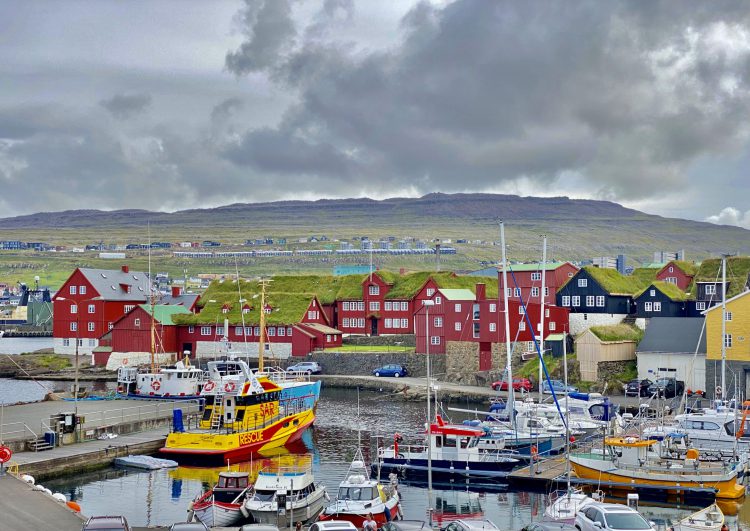
Torshavn is the port and capital of the Faroe Islands that was founded in the 9th century. The red building belongs to the Faroe government; you can find the Prime Minister’s office there.
Our energetic Faroese driver-guide Maria is quite happy with the status quo, because the Faroese people enjoy 99% self-governance and still retain their own language and culture while receiving assistance and support from Denmark. Maria used to work for a couple of years in France, but eventually opted to come back to her village located on one of the Islands.
Maria said because of the tiny population here, the people value their family the most and hold regular family gatherings, especially during weekends and public holidays. And if that’s not enough, they also have music festivals, cultural festivals, harvest festivals and many more community events during the summer months, when the islanders are dressed in their traditional costumes. Such festive joy could never be felt if they were to live overseas.
As such, all Faroese yearn to go back to the islands some day, no matter where they live now. Our 60-year-old taxi driver had also returned after working for many years in Copenhagen, while the young waitresses at the star-rated ROKS restaurant had all come back from overseas.
The Faroe Islands is truly an incredible place. The most charming thing about the place is its superlatively serene beauty that will easily take your breath away. Even though it does snow here, the sea is never frozen, and the temperature ranges between 2°C and 15°C throughout the year. Isn’t that just wonderful?
Leesan, the founder of Apple Vacations, has travelled to 136 countries, seven continents and enjoys sharing his travel stories and insights. He has also authored five books.
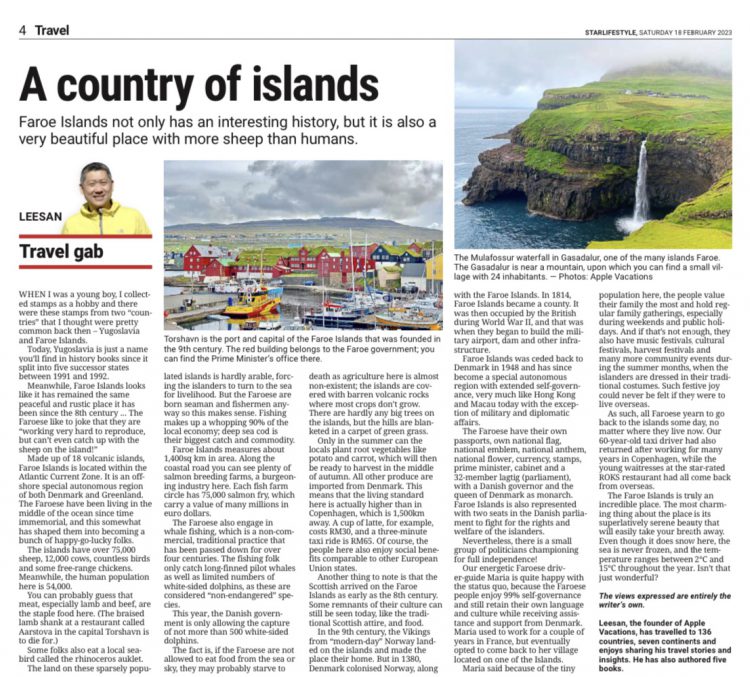
Published in STAR 2, 18 Feb 2023
全球超过80000家酒店,Apple101助您轻松订房,出行无忧,绝对优惠价。入住期间付款,多数客房可免费取消!
